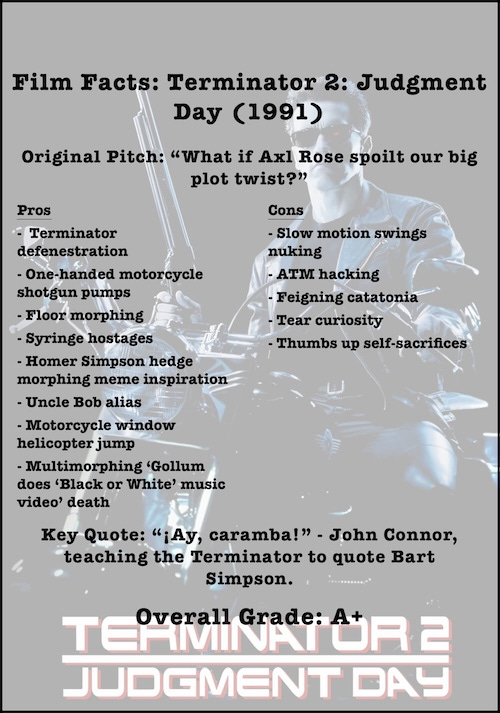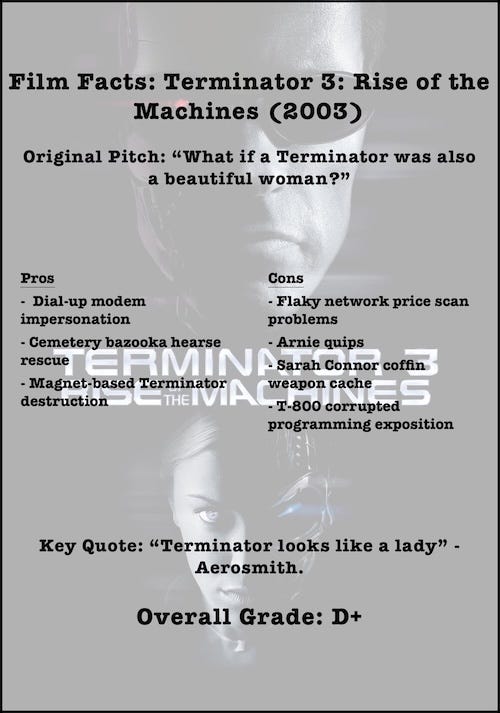T is for Terminator
In which I discuss LLM-generated franchises, the power of Getting Things Done and the tedium of competing timelines
Previously:
Fittingly, given its AI plot foundations, the Terminator franchise could easily be mistaken for a ChatGPT response to the prompt ‘design a new film franchise in the style of the first four franchises I’ve covered so far in this series’.
Like the Alien series, the first two Terminator films are acclaimed genre pieces, with James Cameron reimagining a moody, constrained original movie as a massive action sequel. (Although, unlike with Alien, Cameron was reimagining his own movie for the Terminator sequel.)
Like Jaws, the Terminator series is centred around a cold, merciless killing machine of a villain. An antagonist that ‘can’t be reasoned with’ and who ‘doesn’t feel pity, or remorse, or fear’. (Also, as with the Jaws franchise, it’s a series that gets messier and messier, and strays further from its original core appeal, the deeper into it you go.)
Oh, and that titular antagonist? Seemingly Unbreakable. (ChatGPT might be straining a little hard for a connection here.)
Finally, the Terminator franchise has time travel built into its very fabric (or its mimetic polyalloy, if you prefer), just as Back To The Future does. Although, of course, the two films employ their time travel in very different ways.
In Back To The Future, Marty McFly spends most of his time in the past doing his very best not to get romantically involved with a younger version of his mother. In The Terminator? Kyle Reese heads into the past with at least one eye on the prospect of banging his best friend’s mother, like some kind of time-travelling Pornhub protagonist.
More broadly, Back To The Future is about not disrupting history, with Marty risking the erasure of his own 1985 existence with every 1955 misstep. In contrast, The Terminator’s history bootstraps itself, with John Connor’s existence brought into being by the actions of the time-travelling Reese, who was sent back in time by Connor himself.
There is also, of course, no evidence whatsoever that Biff Tannen is a ruthless cyborg killing machine with a metal endoskeleton covered by living tissue. Nor that it’s George McFly’s density to invent Skynet and trigger worldwide nuclear devastation.
So those are just a few ways for casual viewers of 1980s movies to distinguish between the Back To The Future and The Terminator films.
Another is the differing political themes touched upon by the movies. Back To The Future dabbles lightly in these areas, mostly concerned with questions such as ‘how loud should we play rock’n’roll?’ and ‘horse manure in your car - yes or no?’.
The Terminator, in contrast, dives headfirst into the arguably heavier topics of abortion and gun violence. Both themes are central to the first movie. Abortion is explicitly called out when Reese is interviewed at the police station by Our King of Sneering Scepticism, Dr Silberman, who recontextualises Skynet’s plan of terminating Sarah Connor before John’s conception as ‘sort of a retroactive abortion’. The theme of gun violence is left more implicit, but when the Terminator shoots pretty much everybody in the police station a few scenes later, we more or less get the gist.
There are subtler themes in the original movie, too, some of which are impressively prescient. (Alternatively, those themes were also sent back in time.)
As alluded to in the opening paragraph, the rising threat of artificial intelligence is a core conceit of the plot of The Terminator, and remains so throughout the history of the franchise, even as the real world abilities of artificial intelligence slowly close in on the humanity-destroying capacity of the fictional Skynet. (Having said that, at the time of writing, the major threat of current AI seems to be that it will fuck up all our search engine results. Which, to be fair, is pretty annoying.)
Another forward-looking theme from the first movie is personal productivity. Long before David Allen was teaching people the art of ‘Getting Things Done’, the Terminator was already optimising its to do list in an unwavering targeting of the project outcome by asking itself ‘what’s the next action?’ (the answer? Almost always: ‘kill somebody’). There is a certain brutal satisfaction in the Terminator’s single-minded approach. Adopting the Seven Habits of Highly Effective Killer Cyborgs it relentlessly pursues its goals. No matter what frogs need to be eaten to kill Sarah Connor, we are left with no doubt that the Terminator would chow down on that metaphorical (or literal!) amphibian.
This relentlessness is the key to the Terminator as an antagonist, and the fundamental appeal of the first movie. Yes, the circular time travel plot is intellectually satisfying. And the character development of Linda Hamilton’s Sarah Connor from massive-haired (perhaps because of all the time-travel electricity in the air?), inept, butt-of-ice-cream-in-the-apron-pranks waitress to plastique-wielding, orders-barking, head-crushing kicker of robot butt is almost perfect. (There are a few missteps we can complain about. Having her Florence Nightingale Effect her way into falling for the injured Reese is a weak cliche, for example. On the other hand, Reese’s seduction game is limited (‘The women in your time, what are they like?’ asks Sarah at one point. Reese’s reply: ‘Good fighters.’), so how else are we going to get these crazy kids together?)
The Terminator is ultimately Arnold Schwarzenegger’s movie, though. The former Mr Universe and Mr Olympia had already found box-office success in the role of Mr Conan Barbarian in Conan The Barbarian (and to a lesser extent in the sequel Conan The Destroyer. Will the Conan franchise (including, one imagines, Conan O’Brien Can’t Stop) be my C entry? Spoiler: no).
But Schwarzenegger’s performance as the T-800 in The Terminator took him to a whole other level. And by ‘performance’, I mean, of course, ‘just being a massive musclebound presence with minimal dialogue’. This was a role for which he was perfectly suited. A bodybuilder who had built a body that stretched so far the limits of the human form it became inhuman.
Long before CGI was forced to confront the problem of ‘the uncanny valley’ (the region where audiences are creeped out by computer-generated characters that are almost, but not quite, human), Schwarzenegger wandered that valley in practical form.
But, of course, Schwarzenegger’s disturbing inhumanity was precisely the point of the T-800. He could not have been more purposefully built for the role had he been constructed in a factory and sent back in time for it.
And this, of course, sets up the brilliant reversal of the sequel.
Terminator 2: Judgment Day is a masterpiece of sequel-making. Following the minor critical and commercial success of the first film, James Cameron directs again and builds logically on the original but also makes surprising and satisfying twists on many of the key beats of the first movie’s plot.
The biggest of those surprising and satisfying twists, and the one that powers the entire movie, is the reimagining of Schwarzenegger’s T-800 as a protector rather than a Terminator, a role swap Cameron hides from the audience for as long as he possibly can. For the first half hour of the movie, he instead leads us to believe this is a lesser sequel than it is, one that’s seemingly just repeating the beats of his original movie.
As in The Terminator, Schwarzenegger arrives from the future, swiftly followed by a second visitor who more closely resembles a human being as we understand them. Both time-travellers begin their hunt for a Connor (this time, the squeaky-voiced teenaged John, rather than Sarah).
Just like in the first movie, Schwarzenegger’s T-800 is single-minded in pursuing its goals, brutalising anybody in its path. In contrast, our other visitor (played by Robert Patrick) searches for John in a non-murderous manner reminiscent of the first movie’s Kyle Reese (well, seemingly non-murderous - Cameron cuts away at convenient-in-retrospect times).
Having played with our built-in preconceptions from the first movie, Cameron springs his trap. The two time-travellers converge (Connor-verge?) on John in the corridors of a video game arcade. Schwarzenegger drops the bouquet of roses that hide his gun (a clumsy nod to soundtrack headliners and music video plot twist spoilers Guns’n’Roses) and shoots. The bullets hit our second visitor, and the metallic holes in his body now reveal him to be the notorious shape-shifting T-1000.
Other reversals follow. The unstoppable T-800 from the first movie is this time revealed to be the inferior model, whose only reasonable method of dealing with the upgraded T-1000 is to flee (ideally via thrilling semi-trailer v motorcycle chases). Sarah, soft and innocent at the beginning of the original film, is first seen in the sequel as a lean, focused ball of institutionalised, chin-upping muscle.
Lines from the original are repurposed. ‘Come with me if you want to live’, the T-800 says to Sarah when rescuing her from the insane asylum, echoing Reese’s line from the original. The iconic ‘I’ll be back’? More like ‘I’ll be a callback’ (amirite?) as it, too, gets another run in a different context.
The trio eventually form a bizarre family of sorts, with Sarah musing that this Terminator would make the ideal stepdad. John seems in on the idea, teaching it terrible 1990s slang, as well as instilling Asimov’s Laws of Robotics. (The T-800 already has variants of the second and third laws built into its circuits, programmed to obey John’s orders and unable to self-terminate, respectively. John, however, fulfils Uncle Ike’s I, Robot dreams by adding the ‘no killing’ first law. This, in turn, gives us the wonderfully ridiculous moment of decimal point superfluousness when the T-800’s HUD quantifies the number of human casualties after an onslaught of gunfire as ‘0.0’.)
But the most game-changing twist the sequel pulls is its redefinition of the type of time travel game it’s playing. The first film was a puzzle box of paradoxes that fit perfectly together to create a closed loop. The second movie instead sees our ragtag team of heroes quite literally blow up the idea of closed loop time travel. They detonate Cyberdyne Systems before it can use the left-over arm prop from the T-800 sent back in time by Skynet in the first movie to develop the technology needed to bring Skynet online in the second.
The timeline is thereby successfully rewritten, and humanity saved, but not before we’re gifted two-and-a-half-hours of action movie perfection, including helicopter chases, state-of-the-art liquid metal CGI and a shot that correctly identifies the only acceptable punishment for drinking milk from the carton (namely, a liquid metal knife through the head).
In a better timeline, the Terminator franchise would have stopped there. A magnificent one-two sci-fi movie punch (punch? Sorry, I meant ‘blaze of incessant gunfire’).
But the Terminator franchise, like its titular cyborg assassins, cannot be so easily stopped.
Instead Terminator 3: Rise of the Machines followed, learning every wrong lesson imaginable from Terminator 2.
You like the liquid metal T-1000? You’ll love the T-X, which is not only liquid metal but also a sexy lady Terminator!
You like helicopter chases and liquid nitrogen truck chases? You’ll love hearse, crane and fire engine chases, some of which go on for several hours!
You like John Connor as an annoying teen? You’ll love him as a drugged-out twenty-something!
You like how we repurposed key quotes from the first movie? What about if we did that again? And remember how Arnie said funny things like ‘Hasta la vista, baby’? What if that’s now his schtick in every movie he makes from now on? Also, how about some Claire Danes in your movie? You like that, don’t you? (screaming) Don’t you??
Most disturbingly, with the can of timeline-rewriting worms opened, this one ended with another new timeline that featured Skynet once again triumphant, and John and Claire Danes left with no choice but to start the resistance.
As dumb as Terminator 3 was, Terminator Salvation morphed into something even stupider. A movie best remembered for new John Connor, Christian Bale, losing his shit at a wayward cinematographer, this fresh entry made the mistake of setting itself in the middle of the future war against the machines.
Remember how in the first movie, a lone T-800 was the single most threatening foe imaginable? Turns out that threat is somewhat undercut when Bale and pals spend most of the movie wiping out Terminators of various identification codes by the exploding truckload, as part of an inscrutable Saving Private Reese plot.
(Also, Avatar’s Sam Worthington is a prototype Terminator from the past (or some damn thing) who donated his body to science. Loves donating his body does Sam.)
Terminator Genisys is next, and it completely abandons the timelines of the previous movies (and, frankly, who can blame it?), to riff on the first movie again.
Indeed, for the first hour or so, Terminator Genisys leans into the whole timeline rewriting thing, playfully revisiting the opening scenes of the first movie, in the style of the final act of Back To The Future: Part II. We see the original T-800 sent back in time, and John Connor send Kyle Reese back to protect his mother.
Except, it turns out this time (so to speak) around, Sarah doesn’t need Kyle’s help, possibly because she’s now being played by Daenerys Stormborn of the House Targaryen, Rightful Heir to the Iron Throne, Rightful Queen of the Andals and the First Men, Protector of the Seven Kingdoms, The Mother of Dragons, The Khaleesi of the Great Grass Sea, The Unburnt and The Breaker of Chains, aka Emilia Clarke.
This new variant of Sarah Connor already has her shit together by 1984, having been visited by a T-800 (known affectionately as ‘Pops’, after the elderly Muppet Show doorman) as a child who got her up to speed on the whole Skynet business, and who now hangs around, urging her and Reese to ‘mate’. It’s a genuinely fun and fresh twist on the franchise, a kind of Greatest Hits of the first two movies.
For some reason, however, about 55 minutes in, Sarah and Reese then decide to travel into the future to a much less interesting movie. One where John Connor’s somehow a Terminator, and Skynet goes by the code name ‘Genisys’ and is also inexplicably played by another Targaryen (Matt ‘Damon Targaryen’ Smith).
‘Enough with the Game of Thrones nonsense!’ cries Linda Hamilton, making her badass return for Terminator: Dark Fate. Turns out she’s from yet another timeline, one where a Terminator popped up in a beach bar in 1998 to kill John as a teenager.
She’s now on a mission to protect Dani, a scared young woman out of her depth, from a cyborg killer from the future.
A veteran of the original film handing off to a younger generation is a go-to legacy sequel move, and Sarah reimagined as the new Reese is a perfectly acceptable screenwriting flourish. Even more so when it turns out that Dani is not the new Sarah (destined to give birth to the Resistance leader), but instead the new John (the Resistance leader herself).
But it’s all such a mess that it’s hard to imagine anybody caring any more. Certainly, audiences didn’t, and Terminator: Dark Fate joined 3, Salvation and Genisys as box office disappointments.
Is it even possible to find a timeline in which the Terminator franchise can recover? Probably not. And yet despite the series being stripped of everything that made those first two movies great, and stumbling in jerky stop-motion from reboot to reboot ever since, we know producers will continue to try.
Hollywood can’t be reasoned with and it doesn’t feel pity, or remorse, or fear.
(Well, maybe a little bit of fear. Or maybe even rather a lot of it. But that doesn’t stop it from making terrible sequel decisions.)
— Return to The Master List
If you enjoyed this, you might also enjoy my weird combination memoir/history of superhero comic book series. Or you might not. Only one way to find out, though.














